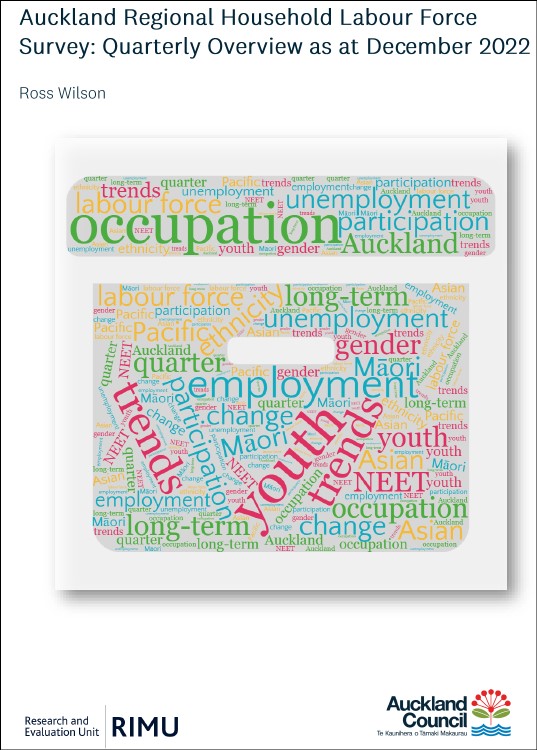Auckland regional household labour force survey: quarterly overview as at December 2022
Author:
Ross WilsonSource:
Auckland Council Research and Evaluation Unit, RIMU | Statistics New ZealandPublication date:
2023Topics:
EconomyAn overview of labour force participation in Auckland, as indicated by results of Stats NZ's quarterly Household Labour Force Survey. HLFS
Overview and highlights
For the December 2022 quarter, compared to the preceding quarter (September 2022) :
• Auckland’s unemployment rate was 3.5%, slightly above 3.3% in September 2022. This and 2021 were Auckland’s lowest December unemployment rates since 2004.
• The number of people who were unemployed rose slightly to 34,700 (+2,100).
• The number of people employed rose slightly to 967,600 (+7,400; full-time +11,800).
• The number of people not in the labour force (NILF) fell slightly to 349,800 (-9,400).
• The labour force participation rate rose slightly to 74.1% (September: 73.4%).
In addition, for the December 2022 quarter:
• The rate of young people aged 15 to 24 not in employment, education or training (NEET) was 10.8%, similar to September (10.7%) and the rest of New Zealand (11.7%).
Over the year ended December 2022, compared to the year ended December 2021:
• The unemployment rate averaged 3.4%, compared to 3.9% in the 12 months to December 2021.
• The age groups with the largest proportionate drops in unemployment rate were those aged 25 to 39, moving from 3.6% to 2.8%, and those aged 40 to 54, moving from 2.5% to 2.0%. Rates across other age groups fell slightly.
• The unemployment rate for females averaged 4.0%, similar to the previous year. The rate for males averaged 3.0% (down from 3.8% a year prior), so the gap between males and females (1.0%) was similar to the 10-year average (1.1%).
• Changes in unemployment rates varied between ethnic groups, with the largest relative decrease in unemployment rate being for Asian peoples (falling by a third to 2.5%) and Pacific peoples (down to 6.8%). European peoples’ rate fell only slightly (to 2.7%), and Māori unemployment rose slightly to 7.9%.
• The labour force participation rate (LFPR) averaged 72.9%, higher than 2021 (71.6%) and the highest in at least 28 years.
• The labour force participation rate for females (68.2% – a record) rose significantly (from 66.3%), but for males (77.8%) the change was smaller (from 77.0%).
• Labour force participation rates rose for all age groups, especially ages 15-19 (46.6%, up 5.5% from 41.1%); ages 55+ (51.5%) and ages 25-39 (87.0 %) hit record highs.
• Labour force participation rates rose for all ethnicities, especially Pacific (66.1%, up 2.7%) and Asian (77.1%, a 2.1% rise), but also Māori (68.6%, up 1.3%) and European (73.8% up 1.1%). All groups were at record levels except Māori (69.9% in June 2018).
In addition, over the year ended December 2022:
• The annual average NEET rate for Auckland was 11.9%, slightly above the rest of New Zealand (11.4%), and slightly below the year ended December 2021 (12.4%).
• Auckland’s NEET rate had not fully recovered (fallen) to the pre-pandemic level.
• Auckland NEET rates were highest for Māori (21.7%) and Pacific (16.5%) ethnicities, Southern Initiative area (18.8%), and those aged 20 to 24 years (14.8%).
Overview published February 2023.
